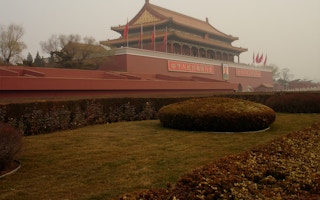As 2016 comes to an end, for observers of China’s environment, the year may leave them with a single impression: that the story is stuck on a loop, repeating itself again and again.
Regardless of whether we talk about the continuing haze ravaging northern China or Changzhou’s “poisoned soil” earlier in the year, the message to the outside world is that China’s environmental problems have not fundamentally changed. Swap the pages of newspapers from 2012 with those in 2016 and you might not notice.
But as with a mathematical model, if the addition of new data renders it impaired then new interpretations must be sought. We encountered many new facts and trends in 2016, which, like the data, are beyond the normal field of reference. These are challenging the old, stereotypical narratives used to explain China’s environment. Below are some of the narratives that are being “loosened”.
“China’s environment is terrible: the air, water and soil are all toxic”
This has been the central theme of reports on China’s environment since the beginning of this century and variations of this continue to appear throughout the world’s media. It is still “correct” to describe the situation this way today.
The annual average levels of PM2.5 in Beijing remain at 80 micrograms per cubic centimentre, still a long way from both the World Health Organization’s target of 35 micrograms per cubic centimetre and Beijing’s own 2017 target of 60 micrograms. Pollution is still a serious issue. But signals in 2016 suggest that this simple picture of China’s environment fails to capture the changes taking place beneath the surface.
In July, a team of British and Chinese scientists published the results of their research in Nature Geoscience that said they believed that China’s coal consumption had peaked around 2014 and that China’s economic growth had, in fact, already decoupled from coal consumption.
In 2013, the argument emerged that China’s coal consumption was reaching a “turning point”, and in 2016 data confirmed this trend. This development was so significant that former director of the National Energy Administration Zhang Guobao said he believed that Chinese officials should formally announce it to the world.
The fact that coal, China’s primary energy source, has reached peak consumption will have a fundamental impact on the country’s air pollution, greenhouse gas emissions and other pollution emissions.
Although air quality is still bad, since the 2013 National Action Plan on Air Pollution was enacted China’s annual average levels of PM2.5 have shown a steady downward trend. Furthermore, China’s carbon dioxide emissions may peak around 2025, earlier than the official estimate of 2030.
The “new normal” period of slowing economic growth has set in and a gradual reduction in water, soil and other kinds of pollution has followed. According to data released by the Ministry of Environmental Protection on November 30, by end 2015, heavy metal emissions had fallen by 27.7 per cent compared with 2007.
Toxic heavy metal pollution is an enormous challenge facing China’s water and soil, as repeated incidents several years ago attest. While the decline in pollution is good news for China’s tattered environment, clearing up the problems left by history will be an arduous task for China for some time to come, as Changzhou’s “poisoned soil” revealed.
“With Chinese local governments’ one-sided pursuit of economic growth, environmental protection regulations are unable to be effectively implemented”
In a discussion of why the Chinese environment is so terrible, two recurring reasons are that “the economy is favoured over the environment”, and “implementation of the law has failed”. For quite a long time this was always the frustrating reality. And to a great extent, these factors still affect China’s environmental footprint today.
Take the games played around plans for coal power plants, for example. Because local governments rely heavily on revenue brought in by the coal power industry, faced with a slowing electricity demand, they launched a huge number of new coal-fired power projects, which caused the National Energy Administration to slam the brakes earlier this year. This shows us that the pursuit of local economic growth still has a profound impact on China’s environmental future.
But a deep-seated reform mechanism is subtly shifting the usefulness of this narrative. In 2014, some regions in China stopped using GDP in local government performance indicators.
In Hebei province, which suffers from the most serious smog, Chinese president Xi Jinping made a direct request for local officials not to get tied up in GDP. In 2016, with the ongoing reform of local government performance evaluation systems, many provinces such as Jiangxi and Anhui began to compile a “natural resources balance sheet” and to carry out “natural resources audits for departing officials”, incorporating natural resources protection into performance indicators for local officials.
Even more striking was that in 2016 China launched environmental inspections across the country. Led by ministerial-level officials, this checked how environmental protection measures were being carried out. Different from the past, this year the focus of inspections switched from companies to government, and emphasised addressing the “local protectionism” from local governments.
The results of the inspection will act as an important basis for the appointment and removal of leading cadres. Following the central environmental inspections of eight provinces this year, disciplinary action was taken against more than 3,000 local government officials, and unprecedented number, while 310 people were detained.
The game between China’s central and local authorities over environmental governance may remain, but the narrative of “local government neglecting environmental protection” could be quietly changing.
“China does not bear its fair share of responsibility for a country that is having such a massive impact on the world environment”
With the whole world watching, the 2009 Copenhagen Climate Conference was a sensational “flop”. In its wake, it left a clamour of mutual accusations, including especially harsh criticism of China, which was blamed for blocking the final deal. Following this, that line of argument became the principal way to evaluate China’s environmental efforts; it even became a reason in the US to oppose climate legislation.
But in the past two years, this narrative has been challenged again and again and now has almost completely been abandoned. Since 2014, China has attracted attention for showing initiative and a positive attitude towards environmental issues such as climate change, the ivory trade and green finance.
In November 2014, the joint statement on tackling climate change made by president Xi Jinping and president Obama alerted the world that the pattern of mutual accusations between China and the US had become a thing of the past in international climate politics. In the statement, China, for the first time, released a timetable to peak carbon emissions.
“
Signals in 2016 suggest that this simple picture of China’s environment fails to capture the changes taking place beneath the surface.
Previously, China had always argued that as a developing country it would not restrict carbon emissions. This ground-breaking act laid a solid foundation for the passing of the historic Paris Agreement (as well as its smooth coming into force this year).
The main driving forces behind China’s shift in its position on the climate and energy issue may be its grave domestic environmental situation and pressure to transform its economy. Actually, we can trace China adopting a greater leadership role in climate diplomacy back to 2013.
That year, when US vice president Joe Biden visited China, China formally accepted a US proposal to “pair with” the US under the G20 framework for the first peer review of fossil fuel subsidies. This offered other G20 countries valuable experience and a model for conducting their own peer reviews. At this September’s G20 summit in Hangzhou, China submitted the results of this peer review, the first clear roadmap and timetable for reform and a huge improvement in terms of policy transparency on this key issue.
Similarly, at this year’s G20 summit, cooperation between the People’s Bank of China and the Bank of England on promoting green finance received wide recognition.
Mirroring its performance in the climate arena, China is also playing a constructive role on other key international environmental issues. As the world’s biggest market for ivory, China’s role in protecting endangered elephant species is critical. After president Xi Jinping’s 2015 visit to the US, when he made a commitment to introduce a complete ban on the domestic ivory trade, the country has been making preparations for the ban and is expected to soon announce the date when it will be enforced.
The most dramatic event of 2016 occurred in November following the US presidential election, when Donald Trump, a man who does not believe in climate change and who has threatened to get rid of the Environmental Protection Agency, was elected president. The world began calling for China to lead the international climate process. This would have been unimaginable just three years ago.
Co-authoring a narrative
Officials, civil society and international parties will co-author the continuing narrative on China’s environment. In 2016, when Chinese officials used the ambitious “13th Five-Year Plan” to set the tone of green growth over the next five years, people in Changzhou, Lianyungang and Chengdu were screaming about their own environmental problems.
Just like several coloured brushes painting a scene on the same canvas, the interaction between these forces will determine how the ecological picture of this country is depicted.
Ma Tianjie is chinadialogue’s managing editor. This story was originally published by chinadialogue under a Creative Commons’ License and was republished with permission.











